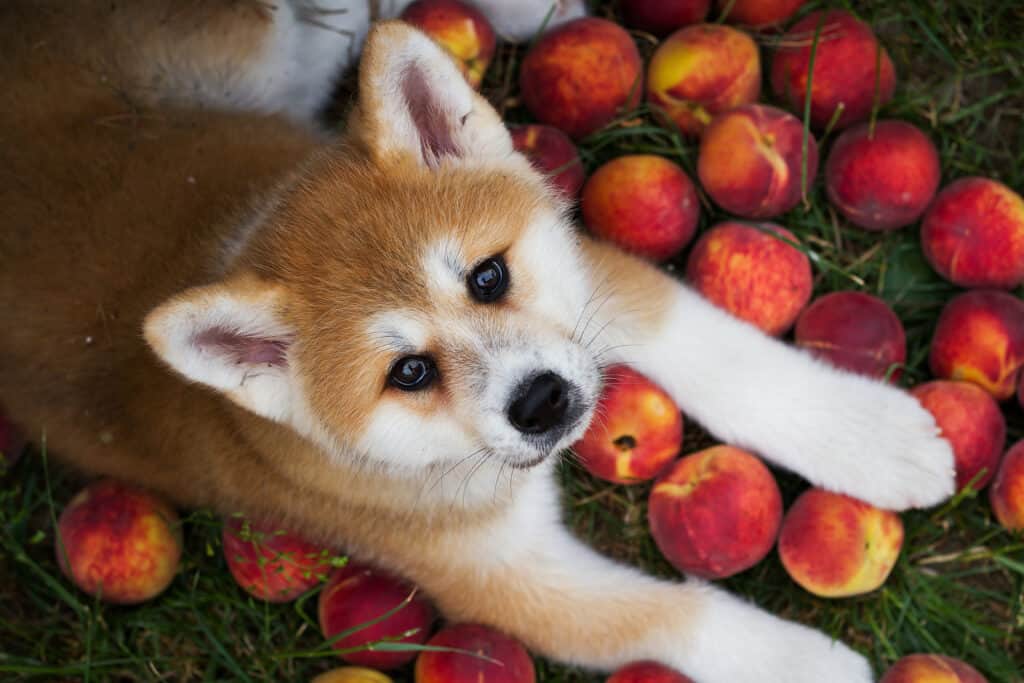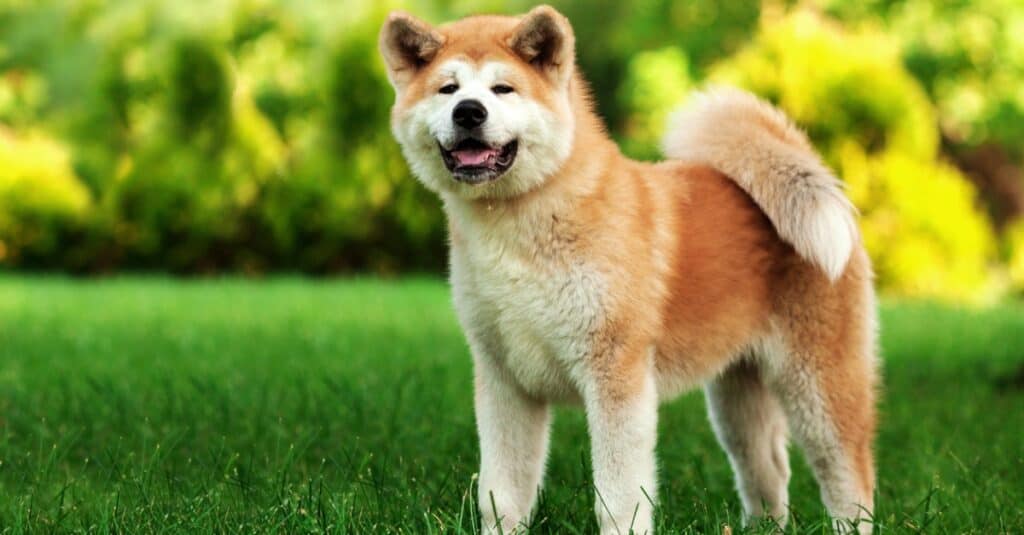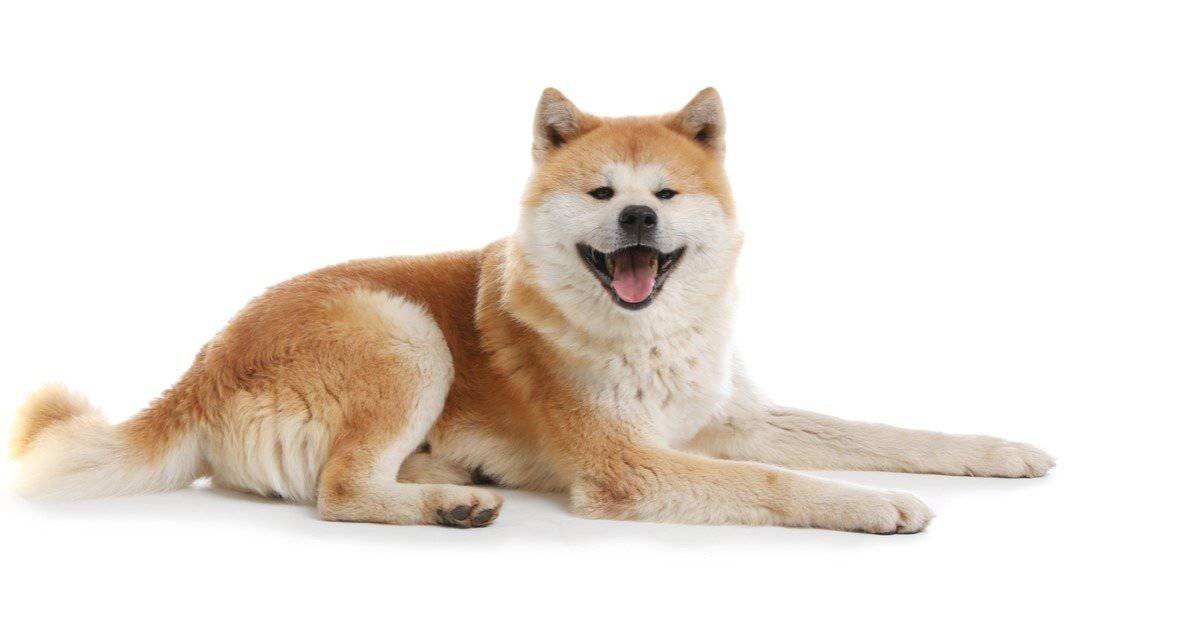What were Akitas bred for? This is a question that has puzzled many dog lovers over the years and one that we aim to answer in this article. Akitas are a beautiful and majestic breed of dog known for their loyalty, strength, and courage. But what was their original role and purpose when they were first developed in Japan centuries ago? Through exploring their history and examining the jobs they were trained to do, we hope to shed some light on the fascinating origins of these remarkable dogs. So join us as we delve into the world of Akita breeding – you might be surprised by what you discover!
History and Jobs of the Akita

Akita dogs were bred for several might purposes.
©New Africa/Shutterstock.com
The history of the Akita breed is a fascinating one that dates back to the early 17th century in Japan’s Akita prefecture. Legend has it that a nobleman, who had been banished by the emperor to rule over the northern province, developed this powerful and versatile breed through generations of selective breeding. People used these dogs for hunting large game such as wild boar, deer, and Yezo bear or Ussuri brown bear. During the 1600s, people used Akitas in dog fighting, which was a once-popular pastime in Japan.
During their early days, Akitas were restricted to the imperial family and their court. However, they soon became popular among hunters due to their impressive abilities in tracking down prey and holding them at bay until their human counterparts arrived on the scene.
In addition to being skilled hunters, Akitas also served other purposes, such as guarding homes and property from intruders. In fact, during World War II, when food was scarce in Japan, having an Akita helped people survive by helping them find food.
Despite this dark period in its past, today’s Akita is widely known for its loyalty and devotion as a family companion dog all over the world. Their intelligence makes them easy to train, while their strong protective instincts make them excellent guardians.
In conclusion, Akitas have come a long way since their humble beginnings as hunting dogs bred exclusively for royalty. Today these magnificent animals are cherished companions adored by many people worldwide!
Akita Legends

The Akita is a protective and loyal breed.
©Tatyana Kuznetsova/Shutterstock.com
The Akita breed has a long and storied history in Japan, playing an important role in the country’s culture and mythology for centuries. Akitas have been the subject of many legends over the years, with stories of their bravery and loyalty passed down from generation to generation. In fact, according to an old custom that dates back hundreds of years, parents will often receive a figurine of an Akita when a new baby is born as a symbol of joy and long life.
One particular Akita who has achieved legendary status in Japan is Hachiko, who lived in Tokyo during the 1920s. Hachiko was the companion of Professor Hidesaburo Ueno, who would take him on his daily commute to work at Tokyo Imperial University. Every day when Professor Ueno returned home from work, Hachiko would be waiting for him at the train station.
Sadly, Professor Ueno suffered a fatal stroke while at work and never returned home. However, despite this tragedy, Hachiko continued to wait for his beloved owner every day at the train station for nearly ten years until his own death.
Hachiko’s incredible loyalty captured the hearts of people all over Japan and beyond, and he became known as one of the most loyal dogs ever recorded in history. Today there are statues erected around Japan dedicated to honoring this faithful canine companion, including one outside Shibuya Station, where he waited faithfully every day.
The First U.S. Akita

Akita dogs make great companions but can be stubborn to train.
©Eve Photography/Shutterstock.com
The Akita breed has had a tumultuous history, with periods of near-extinction. This led to the creation of a breed club in Japan in 1927, which aimed to protect and preserve the Akita lineage. One notable figure who played a role in introducing Akitas to the United States was Helen Keller. In 1937, while visiting Japan, she received two Akitas as gifts. Unfortunately, one of them died young from distemper, but the other – nicknamed Go-Go – became an integral part of Keller’s household for several years.
After World War II ended and American soldiers returned home from serving in the Pacific theater, they brought back Akitas with them. This helped increase awareness and popularity of the breed within the US. The American Kennel Club officially accepted Akitas into its Stud Book in 1972.
Akita Grooming

The wealthy Japanese once held a monopoly on the Akita.
©TatyanaPanova/Shutterstock.com
Akitas are known for their clean and odorless nature, making them a great pet choice for those who value cleanliness. While they do not require extensive grooming, it is important to maintain their thick and luxurious double coat by brushing them at least once a week. This helps the coat retain its natural shine and beauty.
However, Akita owners should prepare for the seasonal shedding that occurs twice a year when the dog’s dense undercoat “blows” out in clumps all over the house. During this time, more frequent brushing can help remove dead hair from the coat and minimize shedding around your home.
In addition to regular brushing, proper nail care is essential to maintain an Akita’s overall health. Overly long nails can cause pain and discomfort for dogs while walking or running, so trimming them regularly is essential.
Lastly, dental hygiene is important when it comes to caring for Akitas. Brushing their teeth frequently with appropriate toothpaste will keep their teeth healthy and prevent bad breath or other dental problems down the line.
Overall, regular grooming practices such as brushing and nail trimming are key components of keeping your Akita happy and healthy in both appearance and comfort.
Akita Exercise
The Akita is a breed that does not require an excessive amount of exercise, but it is important to provide them with a moderate level of physical activity. Taking your Akita for a jog or brisk walk around the block at least once every day can meet their needs and keep them healthy. In addition to regular walks, Akitas also enjoy playing energetically and engaging in activities such as fetch or tug-of-war.
Despite being a large breed, with males often weighing over 100 pounds, Akitas are adaptable dogs that can do well in smaller living spaces if they receive sufficient daily exercise. This quality makes them great pets for apartment dwellers or those without access to large yards.
Originally bred to withstand harsh outdoor conditions in northern Japan, people also used Akitas as house dogs and guardians in addition to hunting tasks. They have adapted very well to life indoors and make excellent companions due to their loyal nature and protective instincts toward their families.
Training

Akitas are highly intelligent and stubborn dogs. Positive reinforcement and patience are needed for training.
©New Africa/Shutterstock.com
Akitas, known for their intelligence and loyalty, possess an independent and headstrong nature that can make training a bit of a challenge. However, due to their large size and immense power, it is crucial that consistent early training begins during puppyhood to ensure they become well-behaved adult dogs. As natural protectors with strong guarding instincts, Akitas must receive extensive socialization from a young age so they learn how to interact with strangers appropriately without perceiving them as threats.
Because of their independence and strong prey drive, Akitas should never be off-leash in areas that are not fully secured. They may exhibit aggression towards other dogs, especially those of the same sex. Therefore canine interactions require extreme caution while being managed carefully by owners or trainers who understand the breed’s tendencies. With proper socialization and obedience training from an early age, however, Akitas can grow up into loyal companions who will fiercely guard family members while maintaining good behavior around others.
Diet

Feeding your Akita a balanced diet is critical to their health and longevity.
©New Africa/Shutterstock.com
As a responsible Akita owner, it is important to pay close attention to your dog’s diet. High-quality dog food, whether store-bought or homemade, with the guidance of your veterinarian, should provide all the necessary nutrients for a healthy Akita. It is also crucial to ensure that the food you choose is appropriate for your dog’s age and stage of life – whether they are a puppy, adult, or senior.
When it comes to older Akitas specifically, some breed experts recommend feeding them a ‘light’ or less calorie-dense diet from around 7 years old as a preventative measure against kidney disease. As with any breed, though, weight management is key in preventing health problems such as joint issues and heart disease. Keep an eye on your Akita’s calorie consumption and weight level, ensuring that treats are given in moderation so as not to cause obesity.
It can be tempting to share human foods with our furry friends, but knowing which ones are safe can be tricky. Do some research on what foods are okay for dogs and avoid giving them anything potentially harmful.
Finally, always make sure clean water is available at all times for your Akita. Some Akitas may become possessive over their food bowl or treats, so ensure they have space away from other animals or children when eating. If you have any concerns about your dog’s weight or diet, then don’t hesitate to speak with your veterinarian, who will be able to offer tailored advice based on their individual needs and circumstances.
Ready to discover the top 10 cutest dog breeds in the entire world?
How about the fastest dogs, the largest dogs and those that are -- quite frankly -- just the kindest dogs on the planet? Each day, AZ Animals sends out lists just like this to our thousands of email subscribers. And the best part? It's FREE. Join today by entering your email below.
Thank you for reading! Have some feedback for us? Contact the AZ Animals editorial team.








